Aloe Vera plants thrive in dry conditions. As they are comfortable growing over deserts, they cannot withstand too much moisture. Aloe Veras will thrive in sandy and rocky soil, which doesn’t retain moisture for a long time. But what about Aloe Vera’s humidity level? Let’s find out.
Aloe Vera plants don’t require high humidity, and they can stay in drought conditions with an average humidity level of 40-50%. Also, they won’t mind even if the humidity drops lower. But, if the humidity is high, the plant will face problems like brown leaves or rotting.
If you continue to keep them under such humid conditions, the plant will end up dying.
This article will give you every detail about the humidity levels of Aloe Vera and ways to maintain the right conditions.
So, read it till the end to understand why Aloe Vera doesn’t enjoy high humidity and what to do about it.
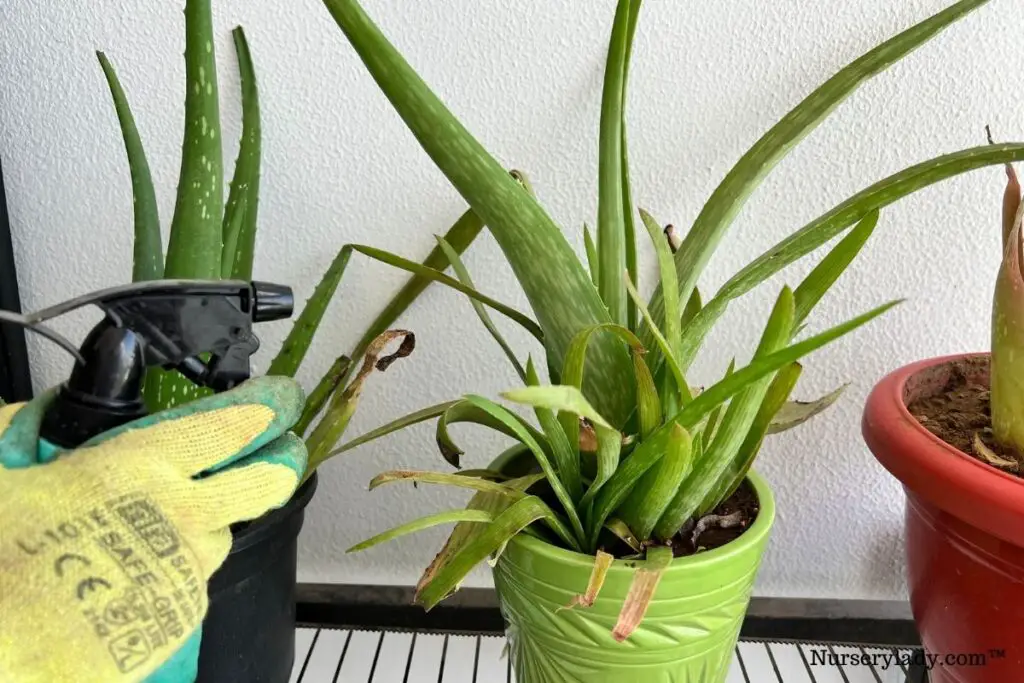
Do Aloe Vera plants need humidity?
Aloe Veras are native to the desert regions of the Arabian Peninsula, where the growing and surrounding conditions are extremely hot and dry.
Moreover, Aloe Vera can also store water in its leaves.
This is the reason they don’t need high humidity to thrive.
However, Aloe Vera can still tolerate a humidity level of 40% to 50%.
They won’t show any negative signs if the level drops too low.
They can survive in dry conditions without any issues.
Outdoors, Aloe Veras don’t face problems from high humidity because they get adequate air circulation and light, which helps dry out the moisture from the plant’s surroundings.
Indoors, an average humidity level ranges within 50%, which is tolerable for humans.
This range should be suitable for the Aloe Vera plants.
Though Aloe Veras are tolerant of many inappropriate conditions, you should care about the humidity.
Always try to maintain their ideal humidity, or the plant will undergo problems.
How to check the humidity level?
There are several ways to detect the right humidity level indoors and outdoors.
Wherever you are placing the Aloe vera, whether outdoors or indoors, you must check the humidity level of that location.
It will ensure your plant’s good health.
Now, what is humidity? More or less, all people are familiar with this term.
Humidity is the amount of water vapor present in the surrounding atmosphere.
The first option to check the humidity is a Hygrometer.
Though they are used mostly indoors, they are also useful for outdoors.
It is a device that measures the relative humidity of the atmosphere and shows it to you on the device’s screen.
A Hygrometer measures both temperature and humidity.
It is cheap and easily available.
Having a Hygrometer will help you in many ways.
If you have a lot of plants and you are concerned about their temperature and humidity levels, one hygrometer will ease up your work.
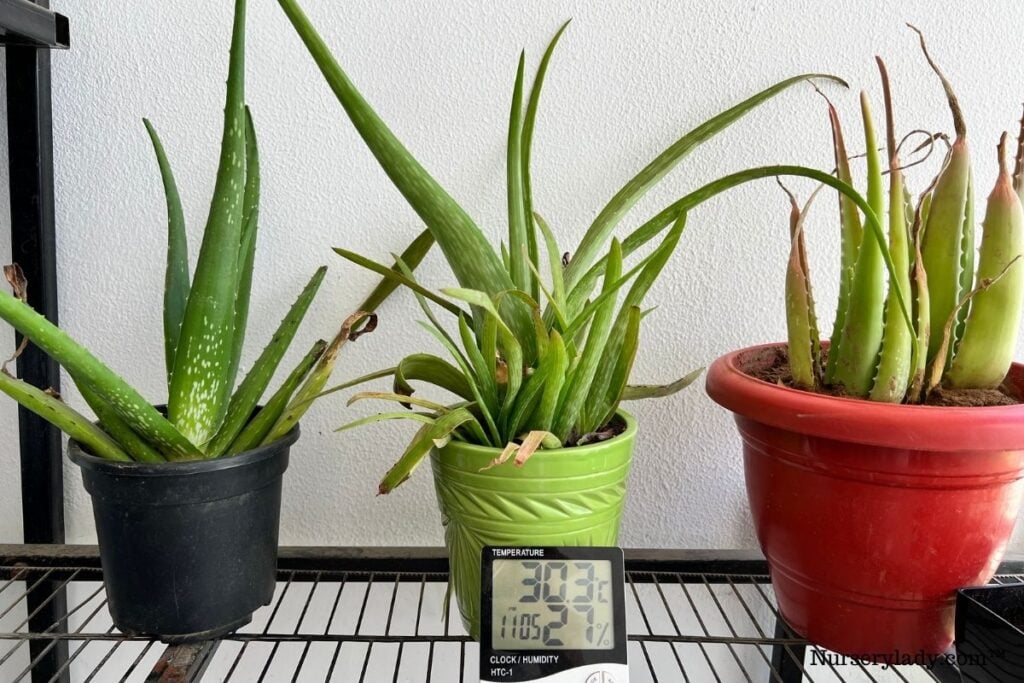
Looking for gardening supplies? We have tested 100's of products before recommending them to you guys. Check out our best pick below:
| Image | Gardening Supplies | Best Price? |
|---|---|---|
 Top
Top Top
Top | Raised Garden Bed Kit | Check On Amazon |
 | XLUX Soil Moisture Meter, Plant Water Monitor, Soil Hygrometer Sensor for Gardening, Farming, Indoor and Outdoor Plants, No Batteries Required | No Results |
 Top
Top Top
Top | 82 Pcs Garden Tools Set and Extra Succulent Tools Set | Check On Amazon |
 | Joeys Garden Expandable Garden Hose with 8 Function Hose Nozzle, Lightweight Anti-Kink Flexible Garden Hoses, Extra Strength Fabric with Double Latex Core, (50 FT, Black) | No Results |
 Top
Top Top
Top | Dual Chamber Compost Tumbler | Check On Amazon |
 Top
Top Top
Top | Sunnyglade Plant Stakes | Check On Amazon |
 Top
Top Top
Top | Organic Cold Pressed Neem Seed Oil | Check On Amazon |
 Top
Top Top
Top | Mighty Mint Gallon :-Insect and Pest Control Peppermint Oil | Check On Amazon |
 Top
Top Top
Top | Scotts DiseaseEx Lawn Fungicide | Check On Amazon |
 Top
Top Top
Top | Jacks Classic 20-20-20 All Purpose Fertilizer | Check On Amazon |
 Top
Top Top
Top | 30,000 Seeds Pollinator Attracting Wildflower Mixture | Check On Amazon |
 Top
Top Top
Top | Survival Vegetable Seeds Garden Kit-Over 16,000 Seeds | Check On Amazon |
Does Aloe Vera need high humidity?
Being native to dry conditions, Aloe Veras does not enjoy high humidity.
The level of humidity must stay relatively around 40%.
They can even endure low humidity levels and thrive under dry conditions.
Sometimes, lack of humidity is an issue for many tropical and warm-climate-loving plants, but Aloe Vera stays fine in such conditions.
If Aloe vera receives extra moisture, it will result in prolonged dampness, brown foliage, rotting, and fungal infections.
It also increases the chances of pest infestation.
Many people misunderstand their features because of their tropical character and love for warm climates.
Since many indoor tropical plants prefer high humidity, people commit the mistake of keeping Aloe Vera in the same group.
If you are growing these plants, you should know that they enjoy dry weather.
Indoors, humidity is a little more than outdoors due to clumsiness and lack of proper air circulation.
If your Aloe Vera is kept outdoors, you don’t have to worry about its humidity level as there is enough airflow.
But indoors, you must take care of this matter and lower the humidity in their surrounding environment.
Even if the humidity level is ideal, you must watch your Aloe Vera plant.
Signs of high humidity in Aloe Vera
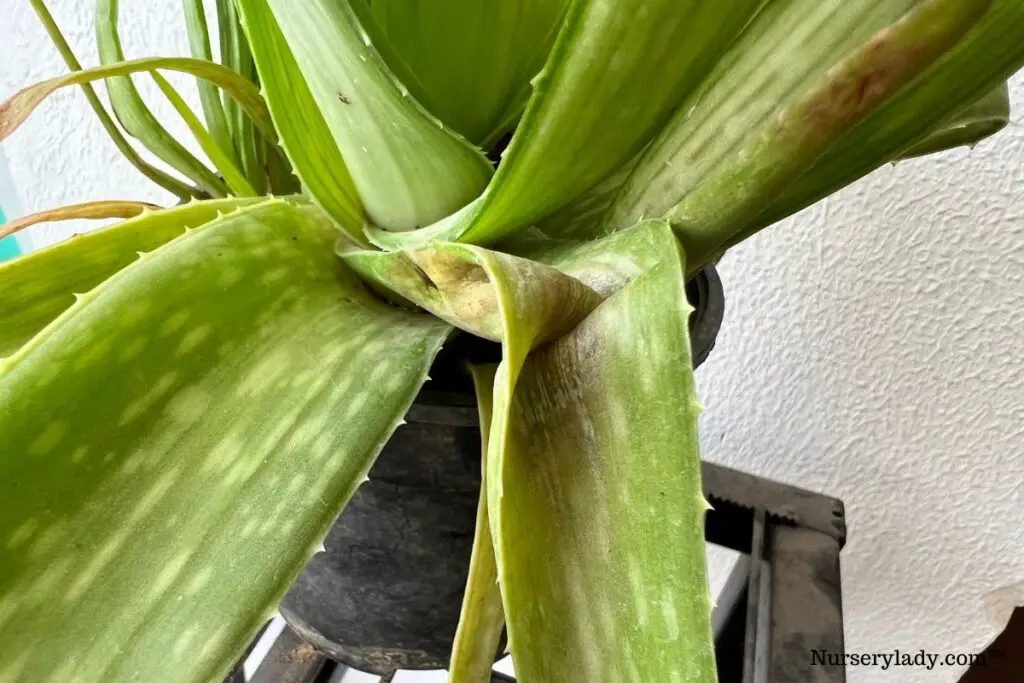
When Aloe Vera gets exposed to high humidity levels, they react negatively.
They display some signs from which you have to understand that they require low humidity.
The symptoms are:
- Brown and mushy leaves due to excessive moisture.
- Edema. These are small brown bumps that occur when the soil is moist, humidity is high and low temperature.
- Mold or powdery mildew formation happens when a hot climate is accompanied by high humidity.
- Brown spots and development of leaf blight.
Ultimately, the plant will start rotting and succumb to death.
Whenever you see these signs, get alarmed and investigate the problem behind it.
Quick action will save the plant from severe injuries.
Once the humidity rises too high, it will block the transpiration rate and slow it down.
As a result, the soil, too, will begin to start staying moist most of the time.
With the right conditions and quick treatment, the plant can return to good health.
However, we have tried to share a few things to fix the humidity problem and create a suitable environment around the Aloe Vera plant.
How to reduce the humidity around Aloe Vera?
Here are a few things to do to keep the humidity around the Aloe Vera plant around 30% to 40%.
Additionally, I will also recommend some of the locations if you are confused about putting your Aloe Vera in an ideal place, especially indoors.
Outdoors plant the Aloe Vera at a location where they receive adequate sunlight.
Adequate light can increase the chances of dryness and thus reduce humidity.
The same goes for airflow.
If your plant gets enough air circulation, which is enough outdoors, the humidity will reduce around the plant automatically.
For indoor plants, place Aloe Vera plants near the open window to get enough sunlight.
Put on sheer curtains to filter the harsh sunlight.
But never deprive them of light.
The sun level already stays low in the winters and much lower indoors.
The plant must stay in dim areas, increasing the humidity.
Artificial light will increase the light requirements and reduce humidity.
Avoid overwatering your Aloe Vera plant.
As I mentioned before, they enjoy dry conditions.
Always avoid moist conditions.
Water sparingly in the winters.
In the summers, Aloe vera goes dormant during the hottest days.
Watering can cause overwatering.
High humidity also becomes a problem during the summers.
Together, they can create a serious problem, so you need to be careful.
Let your Aloe vera have enough air circulation.
Indoors, keep the plant near an open window to let them have some cool breeze.
Even if it is winter, keep your plant near an open window for some time, a few feet back.
It will give them good airflow.
Use fast-draining soil that doesn’t retain moisture for a long time.
Well-drained soil will drain the water faster and keep the soil from staying moist and soggy.
During rain, protect your outdoor Aloe veras by putting on some shades.
If they are in containers, bring them indoors.
Inside, keep them a few feet away from an open window so that the water doesn’t fall over the leaves.
Where should I place my Aloe Vera plant?
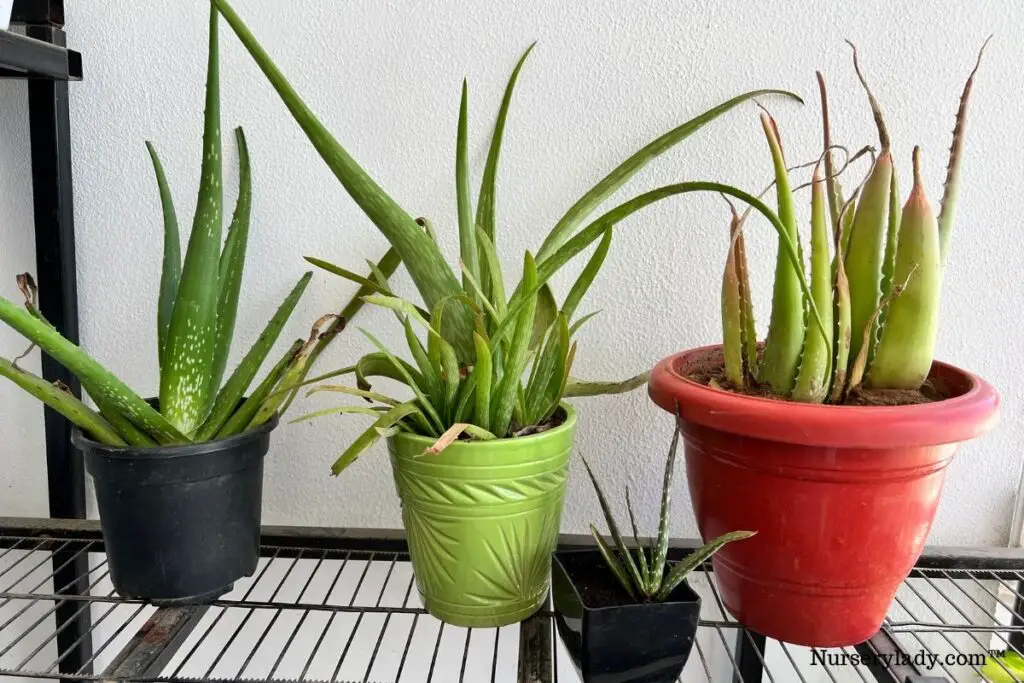
The best place outdoors should be a location with full sun or partial shade.
Aloe Vera must receive adequate sunlight throughout the day.
If not the whole day, at least 5 to 6 hours of sunlight is mandatory.
So, select the sunniest spot in your garden.
The more light they get, the drier they will stay.
The humidity will stay low due to the dry conditions.
Indoors, select south or west-facing windows to let them have enough sunlight.
You can also use artificial lights if the indoor Aloe Veras are not getting enough sunlight.
If the sunlight feels too harsh, you can put on shading nets or curtains to filter it.
Never prevent them from getting sufficient light.
Choose a location where the plant can get enough airflow.
Do not put too many plants close to each other.
Keep at least 3 to 4 inches of space in between for easy ventilation.
Also, do not plant the Aloe Vera under any tall trees.
The dewdrops from the tall trees can fall upon the Aloe Vera and increase the humidity.
So, plant your Aloe vera away from the tall trees.
For indoor Aloe vera, keep it in an open room.
However, if you keep it near a window, the airflow can reduce the humidity to some extent.
You can also use dehumidifiers to reduce the humidity level for your Aloe Vera plants.
Combining Aloe Veras with other tropical plants can also raise the humidity level.
Different rooms happen to have different humidity levels.
For example, the bathroom and kitchen have much higher humidity than your bedroom or drawing-room.
A room with an open window has less humidity than a clumsy room with no window.
So, keep the Aloe Vera at a place where it can receive its ideal humidity range.
Whichever place you choose for your Aloe Vera plant, always ensure that the plant gets enough light and ventilation.
These two are vital things that can help to lower the humidity level.
Why is it important to maintain low humidity around the Aloe Vera plants?
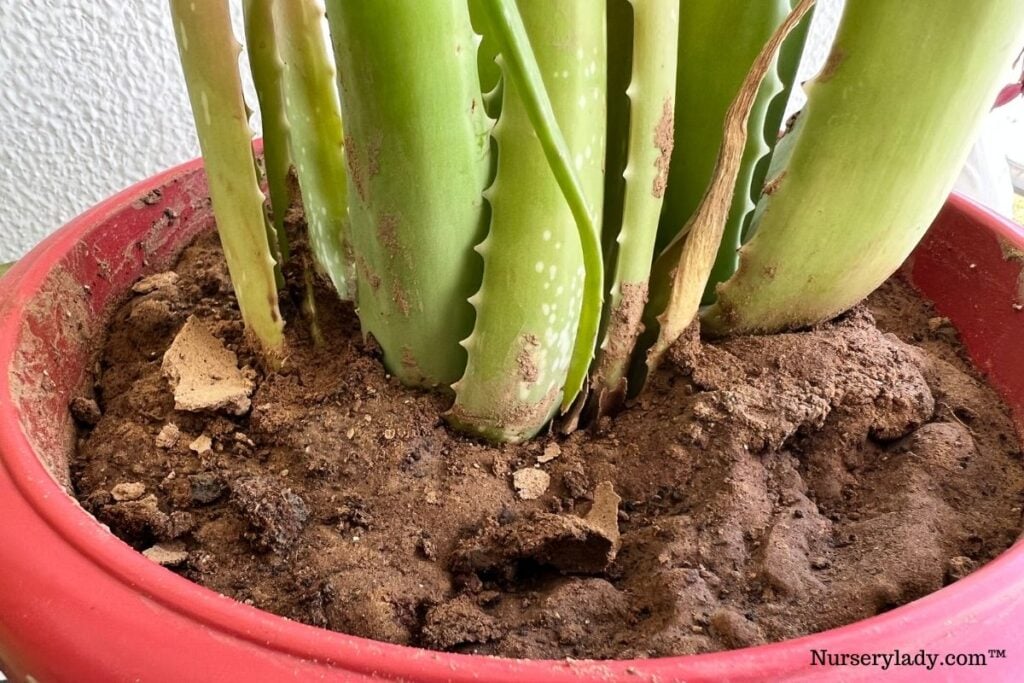
Aloe Vera is habituated to living in warm and dry areas.
They originate from dry weather, warm temperature, adequate airflow, and low humidity.
They absorb the water slowly from the soil, store this moisture for a long time, and use it gradually.
That is why they are sensitive to prolonged dampness and high humidity.
The plant cannot absorb water and nutrients from the soil adequately if the soil stays moist for prolonged periods.
Moreover, too much moisture can cause suffocation, mold, and other fungal infections, especially during hot weather.
When this happens and stays for a longer period, ultimately, the plant makes its path towards root rot and then death.
As a result, they will show certain symptoms like mold, powdery mildew, rotting, and other fungal diseases.
To avoid such drastic conditions, you must ensure that the surrounding environment of the Aloe Vera plants stays dry and low on humidity.
Final words
After the above discussion, you must have understood that Aloe Vera doesn’t enjoy high humidity and the results if they ever get exposed to high humidity for a long time.
You must maintain adequate light and ventilation around your Aloe Vera plants to keep the humidity under control. It should stay within a maximum range of 40-50%, not more than that. They won’t mind even if the humidity reduces below 30%.
You can use hygrometers indoors and outdoors to detect the right humidity level around your Aloe vera. You will know the correct measurements and can amend the surrounding conditions to make it ideal for Aloe Vera plants.
Avoid overwatering, low light conditions, cold temperatures and use well-drained soil to facilitate low humidity around the Aloe Veras.
Reference: NCBI, New York Botanical Garden, University of New Hampshire, University of Florida, Wikipedia.
